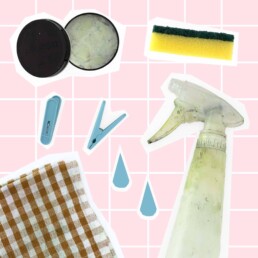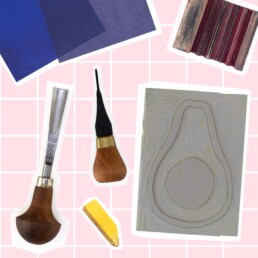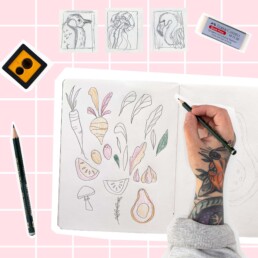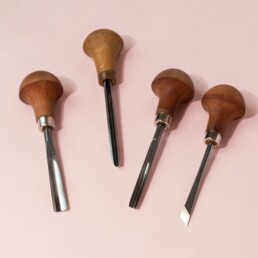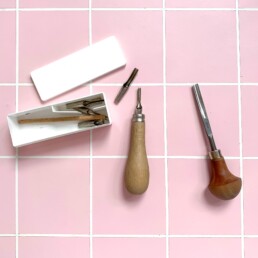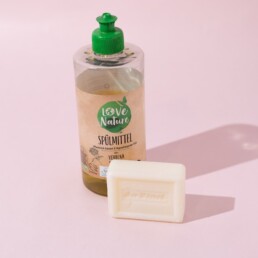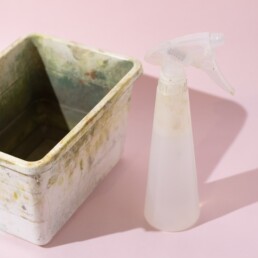Beginner's mistake No. 5
Beginner's mistake #5
Here I have a beginner’s mistake that really hurts – but not physically this time. Cleaning our utensils is part of printing, that’s for sure. But even here, you can make a critical mistake that will ruin your block in the worst case: Rinsing the lino block under the tap.
Traditional gray (and brown) linoleum has jute fibers on the back (hessian back). When those get wet, either completely or in large part, they contract. This causes your lino block to curl or curve convexly. And unfortunately, this cannot be reversed. Printing with such a block is no fun … what you have left is to glue it to a rigid surface. Best not to let it get that far in the first place.
In my online course, cleaning and storing printing supplies is also worth an entire module. In three video lessons, I’ll show you everything you need to know: what a simple, space-saving setup looks like and what rules to follow, how exactly you can and should clean your print supplies quickly and easily, and how to store them afterwards so they’ll last you a long time.
I’d love to see you in my course and guide your journey into the colorful world of lino printing.

Linocut Tool Guide
Still unsure which tools and products you need for your lino printing starter kit? Just download my guide with product recommendations for linocut beginners – on 6 pages I list all the materials and tools I need to make my colorful prints – and you can do it too!
Linocut Beginner's Mistake No. 4
Beginner's Mistake #4
A new day, a new beginner’s mistake! This time from the printing section! This mistake mainly affects those who print with traditional lino, those gray blocks with the jute fiber on the back.
The mistake: You press the lino block onto the paper like a stamp. The order is wrong – the correct order is to put the paper on the block. So block on the bottom, paper on the top! The difference is that you have much more control over your print result. Lino blocks are comparatively inflexible to a stamp made of a rubber material.
As a result of this mistake, your print will probably be missing ink in many places, because you can’t see where more pressure needs to be built up.
If you lay the lino block flat on the table and place the paper on top of it, you can lift the paper in some places during the printing process and see how it is doing. Is there still ink missing? Then either more pressure is needed or more ink! With a little practice, you can easily re-roll the ink. I show you all this in detail in my course. Excellent, opaque and even prints are the goal and we can achieve that together!
Especially when you print without a press, it is even more annoying when a print fails because you have put so much more effort and time into it. Let me show you how we can save prints. Do you want to? Then I would be happy if you join me!

Linocut Tool Guide
Still unsure which tools and products you need for your lino printing starter kit? Just download my guide with product recommendations for linocut beginners – on 6 pages I list all the materials and tools I need to make my colorful prints – and you can do it too!
Beginner's mistake No. 3
Beginner's mistake #3
This mistake is not too bad – but it can still lead to messy and unclean results in the print. You use too much ink.
This can be seen when the ink splatters over the edges or when fine lines are filled with ink and you can no longer recognize them. Another disadvantage is that oil-based ink dries poorly when you use too much of it! Usually a coat of ink dries within a few days. If you use too much ink, it can take weeks.
You can also tell by the sound it makes. Too much ink sounds like you’re walking through mud when you roll it out. While the right amount of ink sounds quieter and more consistent. There’s a video lesson on this in my online course, you can even do the audio test there!
Using too little ink is less of a problem, we can compensate for that quite easily! The secret behind even prints is a combination of ink, paper and pressure. If a print doesn’t turn out quite right, I’m sure we can salvage it together – I’ve picked up a few tricks over the years to get consistent results. In my online course, I’ll be happy to teach you everything you need to know to achieve outstanding print results.
Are you up for it? Then I would be happy if you join!

Linocut Tool Guide
Still unsure which tools and products you need for your lino printing starter kit? Just download my guide with product recommendations for linocut beginners – on 6 pages I list all the materials and tools I need to make my colorful prints – and you can do it too!
Beginner's mistake No. 2
Beginner's mistake #2
This mistake is really critical because you can hurt yourself badly! Carving requires a lot of attention, but you can be as careful as you want – everyone has slipped with the carving tool and pricked their finger.
More often this happens with the inexpensive carving knife sets because they dull very quickly. Then the blades don’t grip the material as well and it happens: you slip. That alone wouldn’t be all that bad – but many creatives who start this hobby place their hands incorrectly and then stab themselves in the finger. Ouch!
But at least the blades were dull, right? Think again! The force you have to exert with blunt blades is incomparably higher. So you ram the blade into your hand, most likely with a lot of force. Okay – horror scenario over, sorry! But seriously, this doesn’t have to happen!
Holding and guiding a tool safely is not difficult at all, just let me show you. And a sharpened tool glides much better through the material and thus you prevent accidents as well. There are more tips and tricks I can teach you – so go ahead, come join my course and you can fully focus on what’s fun! Carving is meditative if you want 😊

Linocut Tool Guide
Still unsure which tools and products you need for your lino printing starter kit? Just download my guide with product recommendations for linocut beginners – on 6 pages I list all the materials and tools I need to make my colorful prints – and you can do it too!
Beginner's Mistake No. 1
Beginner's mistake #1
Well, what do you think is one of the most common mistakes that happen at the beginning of this colorful hobby? I’ll tell you: you forget to mirror your drawing! Especially if you draw directly on the lino block, this is a typical mistake that can happen to EVERYONE and certainly has happened to everyone. I can’t absolve myself of that either, haha! 😄
Also, if you incorporate type into your drawing, the design is then useless. All the more it hurts when you notice this mistake too late while printing …
But: you learn from mistakes and you usually only make them once! Still, it can be super frustrating. If you want to skip mistakes like this, my course teaches you how to approach a drawing for linocut step by step. To do this, you can either work analog or digital, such as with an iPad Pro!
Drawing directly on the lino block may work great for some. But if you want to print multiple layers on top of each other, you’ll have trouble planning just that. For me, using a small drawing in my sketchbook to plan the rough composition has worked well.

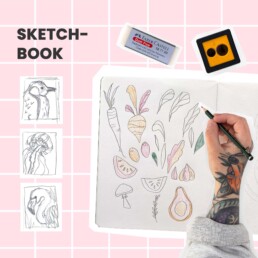
In turn, I get inspiration on Pinterest. Rarely do I just draw away, because planning is an important building block for a balanced design that is easy to print.
In my course, you’ll learn everything you need to get straight into this hobby successfully! We start with a simple design, which we work on together and on the basis of which I guide you through all processes. This way you can concentrate on learning the techniques.

Linocut Tool Guide
Still unsure which tools and products you need for your lino printing starter kit? Just download my guide with product recommendations for linocut beginners – on 6 pages I list all the materials and tools I need to make my colorful prints – and you can do it too!
Instructions for your lino printing starter set
Once your interest in linocut print is sparked, you want to stock up on the necessary tools and products asap, right?
But where do you start? A quick search on Google will spit out beginner sets for you, and that seems all too convenient! But – these sets often consist of inexpensive products that are not very beginner-friendly. Dull blades, hard old linoleum blocks, ink that starts drying during the process. In the worst case, you’ll be frustrated quickly.
I don’t want to criticize all products on the market, but unfortunately this is true for most of the sets you will find during your research.
If you are serious about your hobby and want to have fun with it, you should put together your own starter set from high-quality products that can “compensate” for your (still) missing skill.

If you don’t have time to read, just download my lino tool guide as a PDF and you have a list of useful products for all stages: Design and Transfer, Carving, Printing, Cleaning.
If you’re not sure if you’ll enjoy printing yet, you can sell the products later. In all likelihood, however, you will probably NOT enjoy it if you buy the cheap sets – then the money is definitely wasted.
My recommendations therefore refer to products and tools that I have been working with for years out of conviction – which I present to you now.
Linocut print - What do you need?
For your design you can start on paper, in a sketchbook or on copy paper. If you are brave, you can also draw directly on the linoleum block!
Tracing paper is a great choice for creating designs with multiple layers of color! You can also use tracing paper to store excess ink, more on that later.

Choose your design rather simple and in A5 format. Accordingly, I advise you to buy your linoleum blocks in A5 (or divide an A4 block in the middle). Traditional gray linoleum is less crumbly and softer than brown linoleum. The blocks from Essdee UK are great, I’ve been using them for years.
Note: Lino from your local creative supply store CAN be rock hard. I buy these online only, there’s a higher chance of getting a relatively fresh (and softer) block!
You can transfer your design to the linoleum block using carbon paper or charcoal paper. You place this between the linoleum block and your printout/ drawing and trace all the lines of your design. These are then transferred to the block by the pressure of the pen.
Carving
A mat to protect your workspace is useful – whether you use grayboard, a tablecloth, or a cutting mat is up to you!
The heart of the process is the carving tools. I highly recommend the ones from the Swiss brand Pfeil. Yes, they cost about 16 Euros each (in Germany) – but you won’t need more than 3-4 different sizes. They are a long-term investment in your hobby and an essential factor that decides whether you will find fun in linocut or not. Cheap tools almost always have the disadvantage of not being sharp enough. This makes carving an incredible feat of strength, and what’s more, it can be really dangerous. With blunt tools you slip much faster than with sharp tools!
Which sizes you should get depends on how you want to work. For many fine details you need other sizes than for a reduced style like I have. So my favorites are: Pfeil L 12/4 or L 11/0.5 for line work, L9/5 for coarser work, and L 7/10 or B 7/14 for large-scale background removal.
Useful: a sharpening kit to keep the blades of your tools sharp. This set from Flexcut comes with a sharpening paste and an abrasive and is very easy to use.
Also useful: a hand sweeper to remove linoleum scraps (alternatively: a wide bristled painter’s brush) and large spring clamps to fix the linoleum block to the table. This way you have your hands free while carving.
Printing without a press
Must haves are paper, brayers, a mixing pad, an object to apply pressure, painting knives and inks.
- Paper: I use basic paper from a print shop. 160 gsm from the brand "Design Offset White". Generally, smooth drawing paper in a 120-180 gram range is very suitable and easier to print on than heavy or even textured paper!
- Ink roller: Two different sizes will do for now, like a narrow and a medium size. My favorites are the Speedball Soft Rubber. I do not recommend to go for the rollers with thin steel wire frame and hard rubber. In the beginning, you don't have a feeling for pressure and ink application or application quantity, so the inexpensive rollers are often rather frustrating to use.
- Color mixing pad: For mixing and rolling out the ink you can take a glass plate (IKEA glass shelf), a big tile or a similar smooth surface such as plastic. About A4 size is sufficient.
- Painting knives: To mix ink so-called painting knives are suitable. Two pieces are enough. They are available in sets made of plastic or metal. Here you can reach for cheap products first!
- Pressure: First of all - you do not need a printing press! In the long run, you will certainly want to buy one, but you absolutely do not have to in order to achieve excellent printing results!
A good alternative is the combination of a wooden spoon and a Japanese baren. The baren provides the initial pressure, the wooden spoon (cooking spoon or from salad cutlery for example) is used specifically to rub over the paper and bring the ink from the linoleum block to the paper. - Inks: oil based AND water soluble inks are the best you can buy. Oil based gives great color results and you are not under time pressure when working. Cause water-based inks often dry during the printing process! Then the print becomes very blotchy or in the worst case you have to tear the paper off the linoleum block. If you want to make use of the whole color palette, you only need 5 inks! White, black, blue (Prussian blue), magenta, yellow. The inks from Cranfield are the very best, I have been swearing by them for over 4 years! The exact name is Caligo Safe Wash Relief Ink (green label). Easy to clean with soap and water!
- Drying: Also useful is a clothes rack with pegs to hang the damp prints until they are dry. This takes at least 1 day or longer for oil-based inks. Protect your clothes, the stains from the ink won't wash out. An apron or an old large t-shirt will do the trick.

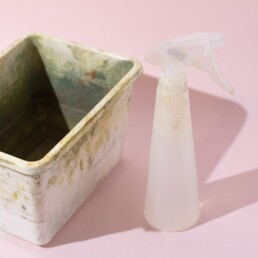
Cleaning
If you use the ink I recommend, you don’t need much for cleaning. A plastic box with cold water, a few old dish towels, a sponge, gloves and soap.
Please never hold the linoleum block under running water! As soon as the jute fibers on the back get wet, the block will warp and be ruined. Therefore, a small plastic box that you fill 1/3 full with water will do. I have linked the cleaning process in this article!
The tracing paper helps you to save excess ink. Cut out a small rectangle (10×10 cm). Use the paint knife to scrape the ink together and wipe it off on the paper. Fold the paper several times and you will get a small package of ink that you can close with a strip of tape. You can get a good insight in this reel on Instagram.
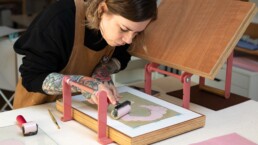
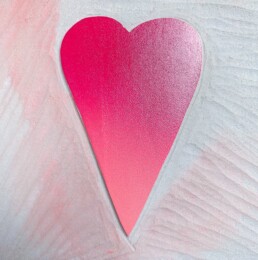
Conclusion
And that’s it for the start! I do not own much more beyond that. Okay, I have accumulated more than five inks and three carving tools over time, but this list gives a very good insight into what you might need in the beginning. Just download my PDF for a quick overview. It contains all the products as a handy list, if you want to put together your own starter kit. I’ll tell you where to get all the products in this blog article.

Linocut Tool Guide
Still unsure which tools and products you need for your lino printing starter kit? Just download my guide with product recommendations for linocut beginners – on 6 pages I list all the materials and tools I need to make my colorful prints – and you can do it too!
These 5 products have frustrated me as a lino printing beginner
When you want to start a new hobby, there is a big fascination at the beginning. You want to understand how everything works and, at best, you already see yourself doing it! Often you are so hyped that you want to start right away. So you watch countless videos and slowly understand how the processes work. If you then want to start yourself, you are faced with the question: What do I buy now? I don’t want to throw money out the window – who knows if I’ll stick with the hobby? So you are often inclined to start with inexpensive products. Totally understandable! HOWEVER, I have to admit that some inexpensive supplies have the opposite effect. Namely, when frustration arises because it simply does not work. And as a beginner, you don’t know if it’s your own technique and lack of knowledge or if the product is unsuitable.
From my experience I can say: There are products where you can save money and don’t have to use high-priced products. And some professional products are much more beginner-friendly than their cheap alternatives.
Therefore, today I present you my top 5 frustration products and their recommended counterparts.
Ink rollers
Round steel frame with hard rubber rollers versus soft rubber roller. The former are probably the cheapest rollers you can find, while my favorites from Speedball Art are in the midfield price wise. Although this is relative, since there are rollers for 60 euros upwards, which are too expensive even for me!
The disadvantage of the round steel frame is that it does not tolerate much pressure. Unfortunately, however, the application of ink is so poor with these rollers that one is inclined to press on harder. Overall, applying ink with these inexpensive rollers is no joy … So the result remains rather uneven, which can have a negative impact on the print.
The soft rubber rollers, on the other hand, are a dream to work with. The ink can be easily and evenly distributed. In cleaning, hard rubber rollers are ahead, but for me the printing result has priority over cleaning a utensil.


Ink - water or oil-based?
I started with large tubes of water-based ink and these Schmincke inks. A well-known company, should be working. Little did I know! While printing, the inks have partially dried, and to print in the summer was almost impossible. With a lot of pressure I tried to achieve an even result. In the end, I had to tear my paper off the linoleum block because it was sticking to it due to the dried ink. Pretty frustrating!
So my answer will always be: Ink for lino printing has to be oil-based AND washable. With oil-based inks, you automatically think of the tricky cleaning issues of having to handle smelly substances. I wouldn’t want that either 😀 Fortunately, there are the wonderful Caligo Safe Wash Relief Inks from Cranfield that combine the best of both worlds. Excellent printing qualities and very easy to clean with soap and water.
Carving tools
Here too, my credo is – please do not save money at the wrong end! With three different blade sizes you can already cover a lot of functions and are wonderful for a starter set. I used this interchangeable blade set during my time at university. A horror! Those in combination with a hard, old linoleum block spoil your fun right away. Because actually, carving can be meditative and relaxing.
Sure, carving is physically demanding – but the difference between a really sharp tool and a blade that gets dull after a short time – is huge! Sharp blades are also much safer for beginners, because you won’t slip as quickly as with dull blades! Mastering your tools and having a feel for them is also paramount for safe work – yet the “cheap carving tools” require much more control and experience than the high quality blades.
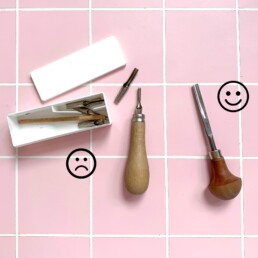
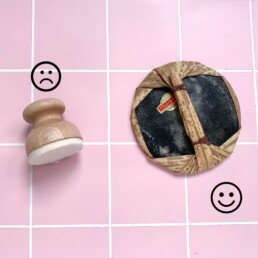
Apply pressure with the baren
My first baren was not really suitable for my project. You can use the felt baren for small stamp motifs for sure, but it’s nothing for lino printing. You can’t build up the pressure you need with it. Instead, the Japanese baren has been working wonderfully for almost 4 years now! You only make the first initial pressing with it and then switch to a wooden spoon, but it’s still part of the routine!
Paper - you can save here!
Fancy watercolor paper or heavy handmade paper with 300 gsm are eye-catchers! They feel luxurious and convey a certain value. However, these papers are not necessarily recommended for beginners and printing by hand. For a homogeneous print result, you need much more pressure and time. In contrast, papers in the 130-180 gsm range are much easier to print on, especially if it has little or no texture. My favorite paper comes from the print shop, 160 gsm, paper type “Design Offset White”. Similar papers can be found under the name “Cartridge”. Paper is certainly a matter of taste and also depends on your design. Monochrome floral designs can be perfected with a handmade paper. For beginners, I would advise choosing a paper that is easy to print on and then playing around as you gain experience.
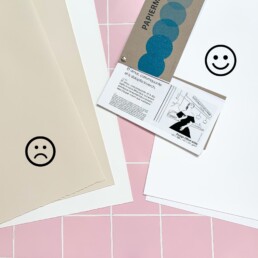
Poor print results can be so frustrating. And even though trial and error is part of learning a hobby, we also need the “quick wins” to motivate us. The more often we do a thing, the better we get at it – but the “wrong products” can quickly take away our enjoyment.

Conclusion
If you are not sure whether you want to stick with a hobby permanently, it is understandable that you want to save money. Good inks and tools can be resold.
If you already work with one of these products and get along with them well – all the better! I don’t want to say, that they don’t work at all! This might be personal experience and maybe I gave up on them too quickly. But all the products shown were game changers for me so I don’t want to withhold them from you. 😊
If you want to know which products can be useful for a lino printing beginner, download my PDF tool list! And if you want to get really serious about this hobby and make your first multicolor lino printing with the help of step by step instructions that are guaranteed to be frustration free, my online course is certainly interesting for you 🥳.

Linocut Tool Guide
Still unsure which tools and products you need for your lino printing starter kit? Just download my guide with product recommendations for linocut beginners – on 6 pages I list all the materials and tools I need to make my colorful prints – and you can do it too!
Where to buy lino printing supplies?
If you’ve been following me closely over the past few weeks, downloaded my freebie tool list, watched my videos, then you probably now have an idea of what you need as a lino printing beginner (and advanced printer). But where do you get all these products? Since I communicate internationally and you follow me from all over the world, this is not an easy question to answer, as it is difficult for me to put myself in different locations around the world. In this article I also list a bunch of products I use.
Companies websites
Fortunately, some companies whose products I love have listed on their website where they are distributed worldwide. That’s always the first place to look. Alternatively, if your country is not listed, look up neighboring countries and their export rules.
My ink rollers are from Speedball Art
My carving tools are from Pfeil
My linoleum blocks are from Essdee UK
My relief inks are from Cranfield

Germany
There are some art material stores that I like very much, because I can buy everything bundled in one place there. For Germany this is gerstäcker or www.kreativ.de (the stores are identical). Boesner also sells the Pfeil tools and has some stores in Germany, but they don’t sell the inks I’d recommend, so Boesner is only second choice for me. The Dutch store polymetaal.nl is also recommendable (although the website is a bit strange).
Worldwide
In the UK, I like to buy from www.jacksonsart.com* or www.handprinted.co.uk – I also buy the metallic inks from Cranfield there, as I haven’t discovered them in Germany yet. You can also check out amazon – in Germany the selection there is rather poor but in other countries this could be a good source.
Specific links to the products I use:
Inks: Cranfield Caligo Safe Wash *
Cutting Tools: Pfeil *
Rollers: Speedball Soft Rubber Roller *
Brayer: Japanese Bamboo Baren *
Sharpening: Flexcut Slip Strop *
*) Affiliate link/advertising link – The links used are affiliate links. Through a purchase via the link I receive a small donation. But this has no effect on the price for you!

Some more shops that sell printmaking products (found on Cranfields website):
France: www.geant-beaux-arts.fr
Netherlands: www.gerstaecker.nl
Denmark: www.aartdevos.dk
Sweden: www.ibwahlstrom.se
USA: www.dickblick.com
If you can’t find what you’re looking for, do a direct Google search. Unfortunately, I can’t do that for you because the search results are in languages I don’t understand 🤭 Maybe you can find lino printers in your country who you can ask for advice? This will make things a little easier.

Summary
Of course, you don’t have to buy the same products that I present to you. These are always personal recommendations based on my experience, which is why I highlight them. If you can’t find them at all in your area, and you can’t import them inexpensively, see what’s available to you. Because as with any hobby, it will probably not remain with a one-time order of products and you don’t want to go through a difficult ordering process with long shipping times again and again.

Linocut Tool Guide
Still unsure which tools and products you need for your lino printing starter kit? Just download my guide with product recommendations for linocut beginners – on 6 pages I list all the materials and tools I need to make my colorful prints – and you can do it too!
How to clean your relief inks
What is the best way to clean the printing block and roller after printing? Do I need special cleaners? Depending on which ink you use, cleaning is quite easy. Water-based inks are generally easy to clean, so they are particularly suitable for schools and other educational institutions. If you prefer to work with oil-based ink, you can choose between water-soluble and non-water-soluble.
Oil based and washable
The best of both worlds, as I like to say. Some companies have special inks on offer that are ideally suited to lino printing, print perfectly and deliver brilliant, silky glossy print results. Sounds too good to be true? My favorite since the beginning has been these: Caligo Safe Wash Relief Inks by Cranfield Colours. hey asked me to be their printmaking ambassador for a reason because I have been recommending their inks to everyone for 3 years now with 100% conviction.
Other companies also have oil based and water soluble inks available, for example: Speedball Art Professional Relief Ink, Charbonnel Aqua Wash and many more. Just Google “relief ink oil based washable/water soluble” yourself and you should quickly find what you are looking for. So far I have tested Charbonnel and Cranfield myself but I did not like the consistency of Charbonnel
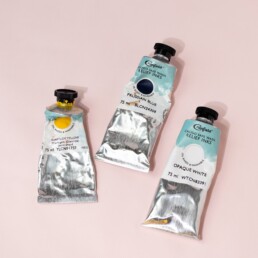
Soap and water
So, how do you clean the oil-based water-soluble inks? With soap and water. I like to use washing-up liquid or curd soap, whereby curd soap cleans a little more thoroughly. Some rollers are not as easy to clean, then you can use a little baby oil or vegetable oil and dissolve the residue.
I clean all my devices at my work table. Put the block on an old cloth, then the back side is protected – because this should not get wet under any circumstances. Otherwise, the burlap incorporated on the back will cause the block to warp, and that can hardly be undone and is really a hindrance for future prints!
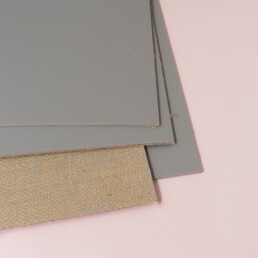

Now I get some fresh water in a (by now very dirty) small plastic box, dip a dishwashing sponge into it and wring it out again. Then I put a dash of dishwashing liquid on it, spread that on the sponge until it gets foamy. You can dissolve the ink on the lino block, mixing plate and roller beforehand with a little water from the spray bottle. Then you just rub the sponge over the block and all the ink comes off. Wipe it off and let it dry, done. It really is that simple. The blocks will no longer become completely clean, but that doesn’t matter, as long as the printing surface is!
Useful tools
Gloves are useful in any case – whether dishwashing glove, latex or nitrile you decide. I personally like nitrile because the gloves do not tear and fit comfortably tight. You should wear some to protect your nails from stains.
If you use oil-based inks that are not water-soluble, then vegetable oil is your best friend – you can dissolve the ink with it. Also useful is a stronger cleaner, such as Zest-It! This does not smell bad and gets off stains from rollers easily (unfortunately not available in Germany).

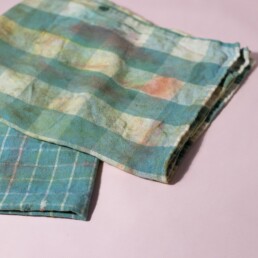
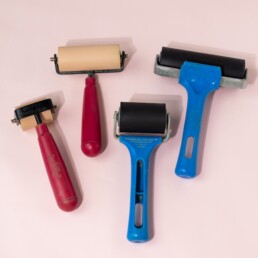
Summary
So, if you want to make it easy for yourself and achieve fantastic printing results, try one of the inks mentioned. I work exclusively with the Caligo Safe Wash Relief Inks from Cranfield, because they are easy to buy in Germany and many other countries.
More useful products can be found in this article: Linocut Printing Tools for Beginners

Linocut Tool Guide
Still unsure which tools and products you need for your lino printing starter kit? Just download my guide with product recommendations for linocut beginners – on 6 pages I list all the materials and tools I need to make my colorful prints – and you can do it too!
Do I need a printing press?
To make a long story short: It depends, as always. I worked without a press for the first 1.5 years and it worked well. But once you’ve had the pleasure of a press, you probably won’t want to miss it. But this is certain: you don’t need a press to get good printing results from your linoleum block! It just takes more effort.
The alternatives
But first I would like to show the alternatives to a printing press. Very useful are the so called barens. There are many different variations, the bamboo baren is the traditional tool in Japanese woodblock printing and also works very well for linoleum printing. It has a handle by which you can grip it and rub it across the paper in circular motions. I wouldn’t rely solely on that, though – I use it for a first pressing of the paper onto the linoleum block.
The other baren shown in the pictures is by Speedball Art and has a hard padded surface. This glides very nicely over the paper without damaging it, so it’s a useful tool I do recommend.


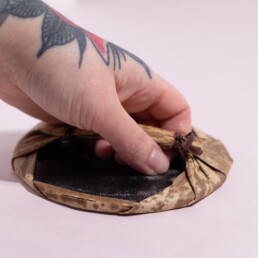
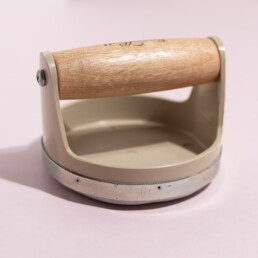

Wooden spoon
However, the wooden spoon is indispensable. You may be asking yourself whether a metal one is possible as well? Basically yes, but the metal can get quite warm, depending on how long and consistently you rub the paper! My wooden spoon was once part of a salad servers, you can also use those for cooking as long as the surface isn’t rough, cause can damage the paper.
You rub the spoon in circular movements over the ares of the design on your block, means you spare out the background, that you carved away. Therefore, the paper must be placed ON the block – and not, as is often done when stamping, block on paper.
Over time, the areas of the spoon that you rub over the paper will become polished and shiny but there are no disadvantages to this.
Another option are “pinch rollers” – these look very similar to the ink rollers and can also be used for this purpose. They are not my personal preference, cause you can’t build up the necessary pressure with these alone. I also find these less handy and user-friendly in comparison to the barens.
The hand printing press
Now let’s move on to the printing press. There are many different models in many different price ranges available. I limit this blogpost to the hand printing press that I bought in 2020 from Jan, known as Woodzilla Press. It cost 300 euros plus shipping from the Netherlands, and I was able to choose the color from a RAL color chart. It has the size A3, means an A3 paper can be printed with it wonderfully, also everything smaller A3. It was delivered with a felt mat, which distributes the pressure evenly over the entire surface.
Anyone who prints a lot and enjoys printing should consider making this investment, I have never regretted it. My first print with it was a revelation! Because the print result was so evenly and comparatively easily produced that I could hardly believe it.
The fact is that printing by hand (handburnishing) is wonderful, but also requires more patience and strength. You stand in a slightly stooped position for several minutes while you’re printing by hand only! At least, that’s how I always did it. It really goes on your back and causes pain! A high working table can help, but probably not everyone has this at home.
Click here to find out about the Etsy Shop of Jan aka Woodzilla.
If you are from the US, head over to Speedball Art as they sell his presses across the USA und Canada!
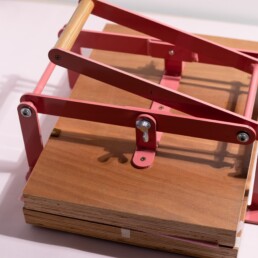
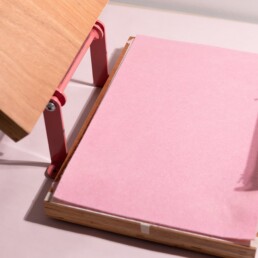

Summary
So my advice to aspiring lino printers is to learn to love the hobby before you buy a press. And as soon as you are ready and can afford it, do it! You won’t regret.
What else you will need as a lino printing beginner, you will learn in this article: Linocut printing tools for beginners

Linocut Tool Guide
Still unsure which tools and products you need for your lino printing starter kit? Just download my guide with product recommendations for linocut beginners – on 6 pages I list all the materials and tools I need to make my colorful prints – and you can do it too!

